|
Related FAQs; Flatworms/Planaria 1,
Flatworms 2, Flatworms 3, & FAQs on:
Flatworm Identification,
Flatworm ID 2, Flatworm ID 3, Flatworm Behavior, Flatworm Compatibility,
Flatworm Control, Predator Control,
Chemical Control, Flatworm Selection, Flatworm Systems, Flatworm Feeding, Flatworm Disease, Flatworm Reproduction,
Related Articles: Pest Flatworm Control by
Anthony Calfo, Worm
Diversity,
/The Conscientious Reef
Aquarist:
Flatworms, including
"Planaria" & Marine Aquariums, Part
5
To: Part 1,
Part 2,
Part 3, Part 4,
Part 6
|
|
|
By Bob Fenner
|
|
Genus Thysanozoon:
| Thysanozoon flavomaculatum Red Sea
image. |
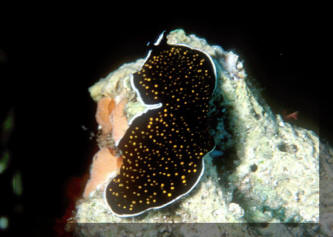
|
Bigger PIX:
The images in this table are linked
to large (desktop size) copies. Click on "framed" images
to go to the larger size. |
|
%20MD.JPG)
|
| Thysanozoon nigropapillosum (Hyman 1969).
Dorsal surface black with short papillae tipped with yellow. White
band around edge. Mid Indian Ocean east to Western Pacific. Photo
taken off Pulau Redang, Malaysia. |
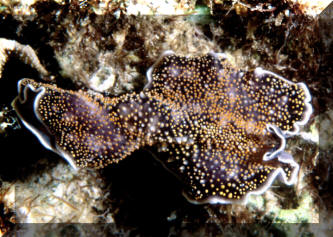
|
Bigger PIX:
The images in this table are linked
to large (desktop size) copies. Click on "framed" images
to go to the larger size. |
|
%20MD.JPG)
|
| Thysanozoon-Acanthozoon sp. Raja Ampat
image. |
%20MD.JPG)
|
A Host of Unknowns:
| An undescribed Euryleptid in Bali 2014.
Indo-West Pacific. To 3 cm, 1.25" |
%20MD.JPG)
|
Bigger PIX:
The images in this table are linked
to large (desktop size) copies. Click on "framed" images
to go to the larger size. |
|
%20MD.JPG)
|
Bigger PIX:
The images in this table are linked
to large (desktop size) copies. Click on "framed" images
to go to the larger size. |
|
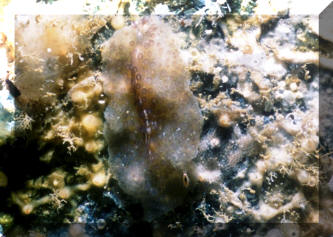
|
Parasitic Flatworms: Black-Spot Disease of Yellow
Tangs
|
My graduate school roommate Mike
Kent worked out the life-cycle of this Platyhelminth,
Paravortex for his Master's Thesis. Other authors list
the use of organo-phosphate containing medications to rid Yellow
Tangs and other fishes (7 families, 130 some species) and their
system of this Turbellarian, but a simple freshwater dip, sans
copper or anything else, wipes them out without having to put
anything in your main system. After this knowledge became common
and a routine freshwater dip procedure was adopted by
wholesalers, we had a Dickens of a time getting more
Paravortex. If your system will accommodate a cleaner
goby, shrimp, by all means include one.
|
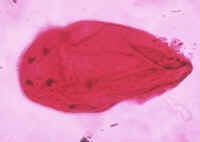
|
Flatworms as Predators!
Bigger PIX:
The images in this table are linked
to large (desktop size) copies. Click on "framed" images
to go to the larger size. |
|
.JPG)
%20MD.JPG)
|
Flatworm Predators on Parade!
Due to their bad taste, often outright toxicity, most flatworms are
unpalatable to predators. However, there are notable exceptions. Some
that may work are listed/pictured below:
| Chelidonura varians Eliot
1903, THE Flatworm Eating Sea Slug!
Tropical Indo-West Pacific. To seven cm. in length. This one off of
Heron Island, Queensland, Australia. |
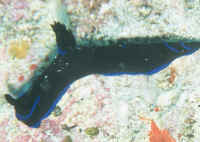
|
| Lysmata wurdemanni (Gibbes 1850), Peppermint
Shrimp, Caribbean Cleaner Shrimp. Tropical West Atlantic. Lives
singly or in groups. Gets along with all aquarium species.
Commercially produced. A reclusive, sometimes misidentified species
(there are other shrimp from the area that are similar) used in the
fight to limit Aiptasia Anemones in aquariums. |
/Lysmata/Lysmata_wurdemanniAQ.jpg)
|
|
Halichoeres chrysus Randall 1981 (1), is a
fish of two "good" and one bad common name. It should
be called the Golden or Canary Wrasse for its bright bold
sun-yellow color, but is most often listed as the Yellow Coris
Wrasse (Arggghhh!, it is not a Coris genus member of course).
This is an exemplary aquarium species that is suitable for
peaceful fish-only and reef systems. To a mere 4 inches or so
total length. Aquarium & S. Sulawesi photos. Eastern Indian
Ocean distribution.
http://fishbase.sinica.edu.tw/Summary/speciesSummary.php?ID=4855&genusname=Halichoeres&speciesname=chrysus
|
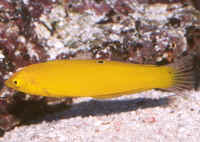
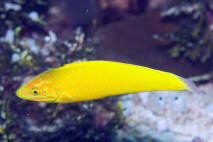
|
|
Pseudocheilinus evanidus Jordan &
Evermann 1903, the Pin-Striped or Striated Wrasse (2). I like
this fish's other common names, the Disappearing or Vanishing
Wrasse for its bashfulness. To a grand size of three inches.
Indo-Pacific, including Red Sea and Hawai'i. Two in the Red
Sea.
|
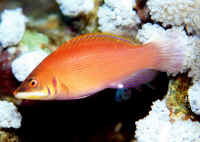 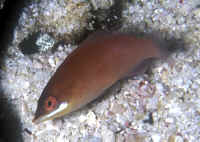
|
| Pseudocheilinus hexataenia (Bleeker 1857),
the Sixline Wrasse (2). A feisty, though small (to 4") a reef
tank species. Indo-Pacific, including the Red Sea in its
distribution. Aquarium and Queensland, Australia images. |
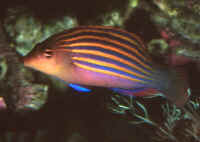 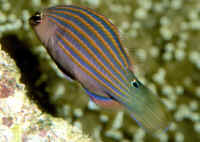
|
Foods/Feeding/Nutrition:
All Polyclad Flatworms are carnivorous, and
specific about their prey. Most feed on sea squirts, bryozoans, small
worms, crustaceans, or snails, but some are cannibalistic.
Reproduction:
Platyhelminths are true hermaphrodites... being
both male and female. Cross-fertilization is the rule with a
"pair" rudely stabbing one another with a hard penile stylet
to enact sperm transfer. As you know due to exposure with Planaria,
they can also generate new individuals by splitting asexually.
To: Part 1,
Part 2,
Part 3, Part 4,
Part 6
|
|

